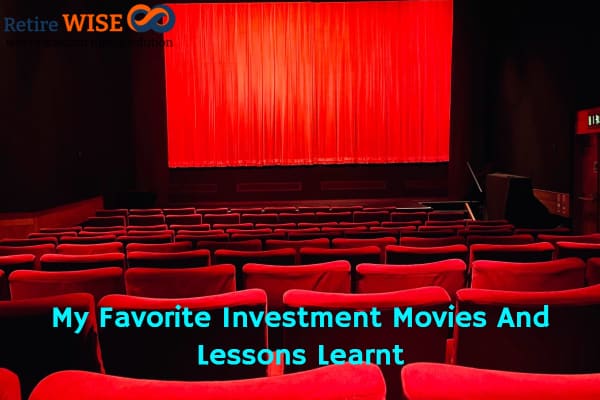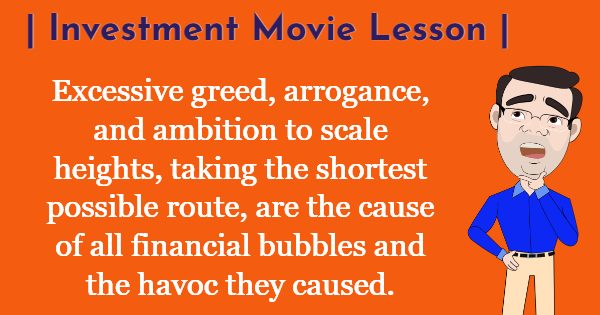If you ever wanted to make money from the stock markets and saw any of the movies that were made with this theme, then most likely you will end up with the thought that “Only crooks operate on the Wall Street/Dalal Street, and I do not belong here.”

Must Check – Most Important Mutual Fund Questions
Most of the movies with stock markets and investments in the backdrop are either about how the greed of some people can create havoc, how under fear people make wrong decisions, and how chasing quick returns results in financial ruin for the most.
The financial world gives all the great ingredients to make great cinema with drama, scheming, twists, turns, plots, tragedy, ingenuity, catastrophe, redemption, and sometimes comedy. Most of the movies/documentaries have been built on true stories, real-life incidents, and portray executives at the financial high table in poor light. Their unbelievable tales of excesses, greed, risk-taking on other people’s money, and arrogance make for compelling screenplays.
Here are my top 5 Favorite Investment Movies. I think everyone must watch.
1. Inside Job (2010)
More of a documentary, than a feature film, ‘Inside Job’ was directed by Charles Ferguson. It is about the 2007-08 sub-prime financial crisis and reveals how insiders – from conniving investment bankers to clueless regulators – were responsible for the havoc that rained over the world economy. Charles Ferguson said the film is about the “systemic corruption” of the US financial services industry and the “grave consequences of that systemic corruption“.
The gripping pace of the movie won it several awards. It was acclaimed by critics for its research and handling of complex financial transactions & instruments. The film explores in five parts how decade-old systemic changes in policy and banking practices helped create the sub-prime mortgage bubble and its eventual burst. These parts were:
- How We Got Here
- The Bubble
- The Crisis
- Accountability
- Where We Are Now.
The documentary does not fail mention the prescient views of Raghuram Rajan, then Chief Economist at the IMF, at the Federal Reserve annual Jackson Hole conference in 2005. In that meeting, Rajan had warned about the growing fault lines and risks in the financial system and proposed ways to mitigate such risks. A former US Treasury Secretary Lawrence Summers called Rajan a “luddite” and his warnings “misguided!”
Read – Personal Finance Lessons from the Olympics
2. Wall Street (1987)
The film holds the place of classics in the financial world for the portrayal of Gordon Gekko played by Michael Douglas. This movie made the cath phrase “greed is good” quite popular among investment bankers of the time.
The story revolves around an ambitious trader who seeks his role model in an unscrupulous corporate raider with no moral compass. The protagonist would go to any lengths – including insider trading or dealing in illegal insider information – to get rich quick.
Oliver Stone directed this classic where the financial wheeling and dealing were taken to be par for course in the financial world and looked convincing. The film clearly shows the excesses and hedonism associated star fund managers, bankers, and Wall Street heroes.
3. The Big Short (2015)
The biggest short-selling trade of history, till date, was the backdrop of this movie. Short selling means that you bet against an asset that is rising in its market price and popularity, with the hope that the tide will turn, and the price will crash. The short seller will then make the most money, while the bulls will lie in tatters.
Just before the housing bubble burst, a substantial short-sell order was placed, betting against the biggest investment banks, funds, and insurance players of the time. These short sellers were in effect betting against the home of the American citizens, or to be more precisely the unwarranted and unsubstantial rise in the home equity.
Many Americans had, by that time, taken mortgages up to 3x to 5x the real value of their homes, because easy money was raising the prices overnight. Banks were willing or even coaxing the homeowners to take loans at easy rates, and most of this money was being splurged not reinvested. A powerful group of investment firms saw the flaw in the whole system and placed their bet on the bubble bursting sooner than later.

Read More –Aligning Investing with Life Goals
In many ways, The Big Short, an Oscar winner, is a dark comedy-drama, directed by Adam McKay, and is based on Michael Lewis’ 2010 book “The Big Short: Inside the Doomsday Machine.” The strong performances by lead actors Christian Bale, Steve Carell, Ryan Gosling, and Brad Pitt and the supporting cast made it gripping and riveting.
The pace becomes a big challenge for someone who does not understand the jargon thrown in every few worlds. So, if you want to really understand and enjoy the movie, you might have to rewind it many times!
The unconventional ways to explain complex financial jargon and their impact on you, the director used cameo appearances by actress Margot Robbie, singer Selena Gomez, chef Anthony Bourdain, and economist Richard Thaler. Ryan Gosling addresses the audience directly at many instances and serves as the narrator.
4. Margin Call (2011)
The 24-hour thought-provoking drama directed by J.C. Chandor is a story about a fictional firm in the Wall Street. This movie also revolves around the 2008 financial crisis but follows people in investment banks over a 24-hour period, just before the bubble burst officially.
The operations, motivations, misgivings, and instincts of the people who populate the large corner offices at “too big to fail” financial institutions were shown with surgical precision.
In case of a leveraged trade, you bought shares with borrowed money with the same securities kept as the collateral, there is always a possibility of a margin call. Leveraged trades define a margin, as a percentage of the price of the security, that the investor has to keep in cash with their broker. For example, if the margin is set at 25%, then with a Rs.1-lakh deposit you can buy up to Rs. 4-lakhs worth of securities. The difference is what you have borrowed from your broker.
If the value of the securities falls then you are in trouble and a margin call is made. In the above example if the securities fall to Rs. 2-lakhs, then you will owe your broker Rs. 1-lakh (4-lakh trade value minus 2-lakh securities minus 1-lakh deposit) and you will have to make up for the difference immediately.
In stock markets, a margin call does not bode well for an investor, and if the prices are crashing across the board, then the whole system collapses in a matter of minutes. As more investors need to pay for their margin calls, they will sell more stocks for meeting the margin call obligations, spiraling down the prices more, causing more margin calls in the wake.
The film keeps you on the edge of your seat for its entirety with superb performances from Zachary Quinto, Kevin Spacey, Paul Bettany, and Jeremy Irons. It is also dubbed as one of the most accurate movies on matters of complex financial dealing and instruments.
5. Scam 1992
Agreed, this is not a movie but a web series, but how could we not discuss the Big Bull of Indian markets who caused the whole system to float in a bubble, then crash, and in its wake caused it to revamp. Directed by Hansal Mehta and Jai Mehta, this web series is based on the rise and fall of Harshad Mehta.
The stock market scam of 1992 involved many market players and not only Harshad Mehta. Adapted from the book ‘The Scam: Who Won, Who Lost, Who Got Away’ by journalists Sucheta Dalal and Debashish Basu, every episode of the web series is gripping, with superb dialogs, and acting by all actors.
Though for many the protagonist was Harshad Mehta with his famous dialog ‘Risk hai to isq hai,’ for me the protagonist were the journalists Dalal and Basu who unearthed the scam while everyone else was looking the other way. It was their factual & investigative journalism, diving deep into the tranches of fake BRs, transaction slips, invoices, bills, and other documents that forced the hands of the government and RBI to act.
The scam was so big that lakhs of investors lost their life savings in it, and many of them never returned to the stock markets, despite their super returns in the long run. The scars on the psyche of Indian players were so deep, that a new market regulator SEBI was created to regulate stock markets and bring some semblance of control.
Key Takeaways
These movies, documentaries, and web series are a must-watch for the person who loves a good thriller with real-life drama. What they lack in suspense, they make up for in great screenplays, superb direction, and amazing acting by all actors.
And if you wish to take a few lessons from these movies, then those could be the following:
- The more things change the more they remain the same.
- Excessive greed, arrogance, and ambition to scale heights, taking the shortest possible route, are the cause of all financial bubbles and the havoc they caused.
- There is going to be a repeat of the bubbles like the one in 2002-07 and burst like 2008 because the governments, central banks, and regulators all have done naught to remove or reduce systemic risks and fault lines.
- There is nothing that you could do if you have all your savings tied up in toxic assets for want of super profit and they go belly up. It is a race against time and a question of when and not if.
Please share if you have watched any amazing investment movies recently.
Great article and very informative take away points.
Comments are closed.